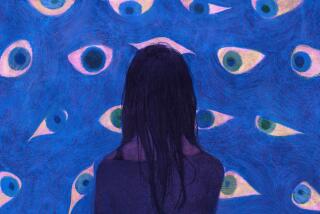Understanding AIDS : Victim of 1980s Plague Helps Schoolchildren Grasp Its Impact
- Share via
A typical school day starts on a typical sunny cool December morning in Pasadena.
On North Los Robles Avenue, 150 seventh- and eighth-graders file noisily into the auditorium of Pasadena Christian School. They pause before venturing into the rows of folding chairs. Most plop down on the nearest seats to the aisle, forcing their classmates to stumble over them down the rows.
Teachers with folded arms hover and call out names of the unruly. Feet swing in brand-name tennis shoes. Heads lean over to whisper. Hands fidget. Adolescent hormones surge and simmer.
Two dozen parents sit segregated in the back rows. They were invited by school officials to this assembly because the subject is a sensitive and controversial one.
AIDS.
Elementary Principal Lainee Allen comes to the podium. She talks to the students about their fears and her own of what has been called the plague of the ‘80s. Then she introduces the morning’s speaker, Jody Simmons, a 32-year-old family alcoholism counselor from North Carolina who happens to be Allen’s sister-in-law.
Simmons has short, curly brown hair framing apple cheeks. She is wearing a white blouse with a lace collar, dark skirt and vest. She peers forward in the way people who wear glasses often do, as if to see better by narrowing the distance to her audience.
She smiles and speaks in the slow twangy cadence of her home state, joking that the students should raise their hands if they can’t understand her. The fidgets stop and the auditorium is quiet as Simmons begins her story at her marriage in 1980.
“I was a preacher’s kid,” she says. “My husband was a preacher’s kid. . . . I did not know that there was a big secret in our life.”
She hesitates, breathes deeply. “In 1984, Ron and I began to have some marital problems. . . . I asked him if there was another woman.” There was no other woman, her husband told her. But he was bisexual.
Simmons says she was shocked and angry. She prayed, and “I felt like God told me that He would help me, so I chose to stay in my marriage.”
The couple tried to talk about Ron’s other life, which had ended when he was in college, but “every time I brought it up I was very resentful and angry,” Simmons admits.
Soon after that came the more general public awareness of acquired immune deficiency syndrome, and the realization that it was affecting more people than homosexual men.
Most medical studies at the time said five years was the longest it could take for a person infected with the AIDS virus to begin to show symptoms of the disease. Since the couple had been married four years and had dated three years before that, they weren’t too worried.
Then, at a job-related workshop in 1987, Simmons heard of a case in which the incubation period was much longer. “When I heard 14 years,” she says, “I just felt this big black emptiness inside, and I thought, oh God, we’re at risk.”
Her husband refused to be tested. Simmons went to her family doctor. “When I got the results and I found out that I was HIV positive, he felt a lot of guilt. He was angry. I was angry. I couldn’t understand. I had been a good girl all my life. How could God permit this to happen to me?”
Presence of the human immunodeficiency virus is the first of three stages in the AIDS abyss; after it comes ARC, or AIDS-related complex; then the condition itself, in which a person’s immune system is so weakened that pneumonia or Kaposi’s sarcoma or some other disease takes over.
Less than a year after Simmons tested positive, her husband, an architect, died of AIDS. She now has ARC.
For these teen-agers and preteens, Simmons’ is a cautionary tale, not only of sex but also of drugs and alcohol. “I was your age at one time,” she says. “I know how difficult it is to say no to a boyfriend or girlfriend, and I know how difficult it is to say no to a group who says come on, just one beer. . . . It’s OK to say no. They may not like it, but AIDS is life and death.”
She answers their questions: There’s no evidence that you can get AIDS from French-kissing, though if kisser or “kissee” has a mouth sore, there would be a danger. No, she doesn’t have children, “and at this point I’m very thankful.”
How does it feel knowing you’re going to die soon?
She has good days and bad days, she tells the students. Her faith has helped her. On the good days, she’ll try to psych her own body, a kind of mental-to-physical pep rally. “Today, I’m optimistic,” she says. “I’m saying, ‘Come on, immune system, let’s build those white cells.’ ”
She even jokes about how, when her illness was first diagnosed and she was standing in a crowded grocery checkout, she thought of calling out, “Hey, I’m HIV positive!” to clear the line.
“But there are days when I feel really sorry for myself. . . . My husband died, and I’m going to die. My prayer is that I die of anything but this disease,” which often renders the victim pitifully insane. “As much as I hate a car wreck, or drowning, I would rather die either of those ways than let this disease take my life.”
And then the talk is over. The students file out. A few of them, and a few parents, come up to thank Simmons, and hug her. The huge Christmas tree covered with big pink bows in the corner of the auditorium glistens.
More to Read
Sign up for Essential California
The most important California stories and recommendations in your inbox every morning.
You may occasionally receive promotional content from the Los Angeles Times.










